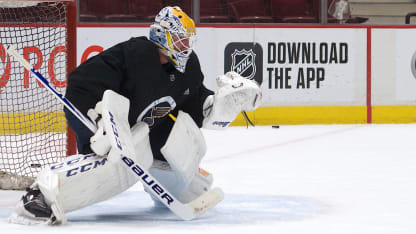After the St. Louis Blues goalie used the same glove for practice that he used for games in junior hockey and his first two pro seasons in the American Hockey League, Allen added a practice glove with a reinforced palm shortly after arriving in the NHL in 2013. He can't imagine life without the extra glove now.
"You get zingers and your whole hand goes numb," Allen said. "Guys shoot so hard."
They also shoot a lot more in practice, with estimates ranging from 200 to 400 shots per practice, depending on the length and type of the session. Goalies rarely face more than 40 shots in a game.
So it shouldn't be shocking that most goalies have invested in a second glove with additional padding, commonly called a practice palm, that is used in nongame situations.
"I feel like I'm going to break my hand if I don't [use a practice glove]," Vancouver Canucks goaltender Jacob Markstrom said. "You take so many shots in practice, and if your eyes are not really tracking the puck 100 percent, it is going to hit you in the palm. You still get stingers with practice gloves, but not as bad so I don't mind. It's heavier too, so it makes the game glove feel a little lighter."
A practice glove typically involves using thicker layers of felt padding in the palm, though the amount varies. CCM and Bauer began using more advanced impact-absorbing products, including D3O and Poron, the material that can be found in everything from cell phone cases to motorcycle apparel.
CCM, for example, offers three levels of palm protection: Game Ready, with a 5/16-inch layer of felt; Pro, with a 1/2-inch layer of felt; and Practice, with two 5/16-inch layers, with the additional option of a D3O foam layer just under the catching surface.
According to the company, the extra layer has led to fewer NHL goalies choosing their thickest Practice palm option, but 80 percent order a second glove with more padding than their game glove.
Not all goalies, however, are comfortable practicing in something different than what they use in games, and the thicker padding in practice gloves makes them harder to close.
"I used a practice glove years ago and hated it," Buffalo Sabres goalie Carter Hutton said. "Felt like a brick, couldn't catch pucks clean, and didn't make sense to me transitioning from that to a game. I use a Pro CCM palm in practice and for games this year went to a Game Ready. It's strictly for games."
New Jersey Devils goalie Mackenzie Blackwood agrees with Hutton.

